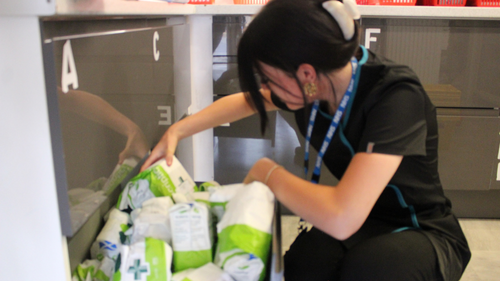Consultation on the Quality Assurance of Pharmacy Education and Training
Published: 21/05/24
The General Pharmaceutical Council is seeking views on changing its approach to the quality assurance of pharmacy education and training.
Pharmacy’s professional regulator, the GPhC, is seeking views on the quality assurance process of all pharmacy education and training. The GPhC has proposed four key changes to the current quality assurance process with the aim to identify educational issues more effectively, act more quickly to address these issues, and to provide more equality in the monitoring and scrutiny process for all providers.
This gives patients and the public the confidence that pharmacists and pharmacy technicians joining the register are skilled and knowledgeable, and that they demonstrate appropriate professional behaviours as a result of their education and training. It also ensures pharmacy education and training takes place safely for all involved and is conducted in a way that is fair and provides a positive experience for students and trainees.
Our response can be found below.
The four key changes to the quality assurance of pharmacy education being proposed are:
Introduce yearly monitoring with greater use of data we collect before the approval event which will enable us to identify and address concerns together with the providers in a more timely, proportionate, and systematic manner.
Define clear lines of responsibility and criteria for making decisions about whether or not to re-approve a course or qualification, including decision-making routes based on the level of assurance we get from providers and whether there is an identified need to intervene.
Adopt a more flexible approval and intervention process so that, as well as continuing to monitor on a regular basis, we will also have the flexibility to intervene more quickly where concerns are identified.
Achieve greater scrutiny by applying our quality assurance processes across all pharmacy education and training which will mean that the same arrangements will apply to all providers.
Section 1: Yearly monitoring
Part of our proposal is to make better use of our data and introduce a yearly monitoring process to improve the quality assurance of education and training. The data we will consider as part of yearly monitoring will include a number of areas on which we will ask the provider to comment.
For example, we will ask about:
the management, oversight and delivery of education and training,
and
the delivery of experiential and interprofessional learning during the academic year
We will also consider data from other sources, such as National Student Surveys (NSS) and student and trainee feedback collected by the GPhC. The yearly monitoring process will build upon our present yearly data collection processes and timings, so that there is a single reporting point each year. This will allow for a more tailored approach to the timing of the approval activities. We will be able to adapt the present three-yearly event cycle, so that timings between events can be changed based on the outcome of yearly monitoring. It will help us, and the providers, maintain oversight of the quality of the education and training provision. It will also help us to spot and deal with concerns early. The overall aim is to assure patients and the public that GPhC standards and requirements for education and training continue to be met.
-
Agree.
-
Agree.
-
Agree.
National Student Surveys (NSS), Post Graduate Taught (PGT) surveys and equivalent subject-level data
Agree.
GPhC registration assessment performance data (pharmacist initial education and training only)
Agree
Oriel assessment performance data (pharmacist initial education and training only)
Agree
Other data (for example, upheld education concerns)
Agree.
-
Agree.
-
The role of the pharmacist and pharmacy technician within a community pharmacy has seen an increase in the utilisation of their clinical skills in the last decade. This approach to clinical service delivery is set to speed up as the definition of these roles are evolved and upgraded, for example, the ability for pharmacy technicians to work under Patient Group Directions (PGDs), and newly qualified pharmacists to have their prescribing qualification integrated into their undergraduate degree. With this evolution, must come the correct support from our educational providers to ensure the new and upskilling workforce are prepared to undertake these advanced roles. As the community pharmacy landscape is constantly changing and developing, so must the quality of the education provided. By introducing yearly monitoring, this will ensure education is up to date and gaps in any future learning structures are noticed before implementation. The yearly monitoring approach seems more proactive than reactive, which is required to support a workforce who will be the next generation of NHS service delivery.
If yearly monitoring looks at qualitative evidence from the range of sources in the guidance, this will also be able to highlight patterns of concern or trends where education may be inconsistent across the country. Capturing feedback from students immediately post-graduation or qualification is key in collecting evidence of course opinions and reflections whilst is still at the forefront of their experience. Reviewing stakeholder feedback as part of the yearly monitoring will give community pharmacy businesses and placement facilitators within them the opportunity to communicate the experiences they have had with students within that year. This also links into gathering feedback on experiential learning, of which community pharmacy provides on average 70% of placement opportunities per year for undergraduate MPharm students. The feedback provided will give educational providers the opportunity to review the practical progress of students and make amendments to education to ensure readiness of the workforce. Once published, reviewing the GPhC registration exam pass rates, for each university cohort across the UK, will improve the direction of action as well.
Section 2: Intervention, escalation and decision-making.
As part of reviewing the information we gather during our yearly monitoring, we will need good decision-making and appropriate ways of dealing with concerns. Therefore, we propose a set of four intervention activities to be carried out by appropriate teams (the GPhC Quality Assurance team, the Approval team or both). These will help us make sure that any concerns are dealt with in the most effective ways and that their impact on the delivery of education and training is as low as possible.
-
To what extent do you agree or disagree that, in each case, the following interventions will strengthen the quality assurance of education and training?
Asking the provider for more evidence and information (for example, action plans).
Agree
Helping the provider with a quality management activity (for example, assessment standard setting)
Agree
Having a focused meeting with the provider (for example, a conversation about the concern)
Agree
Carrying out a focused activity with the provider (for example, a visit or observing teaching)
Agree
-
Agree.
-
The four proposals set out as intervention activities for educational providers seem reasonable and robust. Taking this layered approach will minimise the impact on students and their educational journey. It will ensure that any recommended actions by the GPhC Approval Team will only act to benefit the student journey.
The teams allocated to each type of intervention activity are proportionate and allow for quality assurance to be measured at different levels as part of the yearly monitoring, if required. This also seems appropriate to ensure that cases are only escalated when initial assessment hasn’t been deemed satisfactory. This also ensures the Approval Team’s time is focused where it needs to be and the time allocated is used to help drive improvement.
Section 3: Increased flexibility for approval and intervention.
The proposed update to the quality assurance of education and training will give us more flexibility in the way we approve course provision. We will be able to intervene when we spot concerns, and work with providers to help deal with these quickly. Equally, because of the flexibility we will have with the proposed yearly monitoring and intervention processes, we will no longer publish an ‘end date‘ for our approval. Instead, we will publish a proposed date for the next planned interim or reapproval event .
-
Agree.
-
Agree.
-
Agree.
-
Agree.
-
Flexibility in the quality assurance of education and training providers is essential to ensure areas of concern are being prioritised and adequate time is freely available to address the concerns. This will ultimately lead to quicker outcomes being reached and improvements being implemented in a timely manner to benefit students. This will have a positive impact on all pharmacy sectors and employers of students who will be completing educational courses by the monitored providers.
By increasing continual approval, this creates an understanding of consistent accountability to the development of education within pharmacy. This supports the need for education to be kept current, relevant, and modern in its approach to readying a workforce that will be able to support the growing demand of pharmacy services.
Section 4: Applying our processes across all pharmacy education and training
Pharmacy technician and pharmacy support staff qualifications are delivered and overseen by national awarding organisations. At the moment we reapprove them using a six-year cycle, with an interim event every three years.
This is also the case for Master of Pharmacy (MPharm) degrees delivered by higher education institutions. However, pharmacy technician and pharmacy support staff courses that are delivered by private providers do not have this quality oversight from other organisations. So we reapprove these using a three-year cycle. This reapproval arrangement also applies to the pharmacist independent prescribing programmes delivered by higher education institutions. By introducing yearly monitoring, we will have greater oversight of all courses of pharmacy education and training. Therefore, we propose to apply to private providers and pharmacist independent prescribing providers the same arrangements that apply to national awarding organisations and MPharm providers. In effect, this will result not only in greater scrutiny but in a consistent quality assurance approach overall.
-
Agree.
-
Agree.
-
Consistency is key to ensuring a well-rounded and highly skilled workforce. Applying processes which will enable this across all pharmacy education and training is important to achieve uniformity in the level of skill and knowledge expected of all roles within a pharmacy team. Applying these processes consistently will also support the development of students. For example, if all education providers undergo the same yearly monitoring, common themes from the feedback should be detectable and should provide wider feedback for all education providers. This will help to develop stability in the quality and content of what is being taught. In community pharmacy, there is a need for consistency in education to allow for upskilling of the entire pharmacy team but also for the employer to understand that the quality of education is aligned. This will support a community pharmacy business to be able to confidently provide more services, as a greater, more consistent skillset will be available.
Section 5: The impact of our proposals
-
These are:
- age
- disability
- gender reassignment
- marriage and civil partnership
- pregnancy and maternity
- race
- religion or belief
- sex
- sexual orientation
Do you think our proposals will have a positive or negative impact on individuals or groups who share each of the protected characteristics?
Yes - positive impact
-
- students and trainees
- patients and the public
- education and training providers and partners
- pharmacy staff
- employers
Do you think our proposals will have a positive or negative impact on each of these groups?
Yes - positive impact
-
Community Pharmacy Scotland (CPS) represents the majority of community pharmacy businesses and their teams within Scotland. We are therefore looking at the impact this would have on employers within community pharmacy and the upskilling of new and existing staff within this setting. The proposals set out ensure the quality assurance process is positive and will provide more frequent but flexible actions to be taken to ensure standards in education. Consequently, the level of skill and knowledge of students undergoing pharmacy education should be fit for purpose in an evolving and increasingly more clinical role. As the demand for clinical service delivery within community pharmacy continues, it is important for the proposals to encourage modernity and relevance in all pharmacy education, so the workforce can deliver.

















Response to Scottish Government’s consultation on a new Long Term Conditions Framework, supporting a shift from condition-specific policies to a more integrated, equitable, and patient-centred approach.